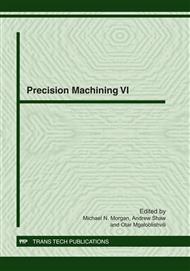p.162
p.168
p.176
p.182
p.188
p.194
p.200
p.205
p.211
Optimizing Heat Transfer Rate in an Internally Cooled Cutting Tool: FE- Based Design Analysis and Experimental Study
Abstract:
The machining process produces high local temperatures in the tool-chip and tool-workpiece contact areas, normally lead to negative influence on the machine performance. This paper presents a study on optimizing the internal micro channel structure of a tungsten carbide (WC) cutting tool in order to enhance heat transfer rate when applied with internal cooling fluid. Inspired by water jet impingement theory, the efficiency and heat transfer rate of single phase micro channel mainly depends on the fluid velocity as well as temperature difference between the cooling fluid and hot surface. In this study three variables, i.e. the space between channel and internal wall of the insert, channel diameter and fluid temperature, have been tested with design of experiments (DoE) to study the significance of the factors and interactions between them on cutting temperature. A 3-D finite element (FE) model has been developed to observe the effects of these factors on heat transfer rate. The simulation results show the most dominant factor to affect the cutting temperature is the temperature of the cooling fluid followed by the space between channel and tool insert internal wall.
Info:
Periodical:
Pages:
188-193
Citation:
Online since:
December 2011
Authors:
Price:
Сopyright:
© 2012 Trans Tech Publications Ltd. All Rights Reserved
Share:
Citation:


